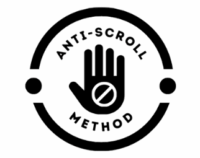You think you’re addicted to your phone—but it goes deeper than that. What looks like distraction or habit is often something far more rooted in the body: nervous system and phone addiction are deeply connected. The urge to scroll isn’t random. It’s your body’s way of seeking relief, regulation, and a temporary escape from the discomfort that lives under the surface.
You don’t reach for your phone because you’re bored. You reach for it because your body is seeking regulation. It’s your way of calming discomfort, avoiding stillness, or softening anxiety. The screen becomes your coping mechanism. And while that’s not your fault, it’s also not sustainable.
How Your Nervous System Drives Compulsive Phone Use (Phone Addiction)
Your nervous system is designed to keep you safe. It scans for threat, manages stress, and regulates emotion. When your environment feels overwhelming—or when your inner world gets too loud—your body moves into a state of dysregulation. You might feel anxious, frozen, disconnected, or agitated.
Instead of sitting with that discomfort, your brain reaches for something familiar and fast. A scroll. A ping. A feed full of content designed to hook your attention and shift your emotional state in seconds.
This is where the cycle begins.
You’re not just addicted to scrolling. You’re addicted to the relief it gives your nervous system. Even if that relief is temporary and shallow.
This is something I go deeper into in Your Scrolling Is Draining You — a post that explores how endless input keeps you emotionally flat and overstimulated.
Why You Can’t Just “Use Your Phone Less”
You’ve probably tried to cut back. You’ve deleted apps, turned off notifications, maybe even done a digital detox. And yet, the urge comes back. That moment of silence hits, and your hand reaches for your phone before your brain even catches up.
This isn’t because you’re weak or lazy. It’s because you haven’t addressed the real reason behind your phone use.
You’re not just trying to pass time—you’re trying to soothe your system.
Until you find new ways to regulate your nervous system, your body will keep going back to what it knows: the screen.
If this feels familiar, you’ll find deeper strategies in Break Your Phone Addiction — a post that helps you create new rhythms without relying on willpower alone.
Nervous System Dysregulation and Screen Time
Let’s break it down simply. Your nervous system has three main states:
- Regulated: You feel calm, focused, grounded.
- Hyperaroused: You feel anxious, wired, overwhelmed.
- Hypoaroused: You feel flat, numb, checked out.
When you scroll endlessly, you’re often bouncing between these states. You might start scrolling to escape stress, but an hour later you feel foggy, detached, and even more anxious. That’s your nervous system reacting to overstimulation, not just your eyes getting tired.
This back-and-forth leaves you dysregulated—and more likely to keep scrolling just to feel something different.
This connects to what I wrote in Why You Can’t Focus Anymore — where focus becomes impossible when your nervous system is caught in a loop of reaction instead of restoration.
How to Regulate Without Your Phone
If your phone is your go-to for emotional relief, the idea of stepping away can feel threatening. That’s why the solution isn’t just discipline—it’s replacement. You need alternative tools that your body can trust.
Grounding Through the Senses
Notice what you can see, hear, feel, smell, and taste in this moment. Place your bare feet on the floor. Run your hands under cold water. Light a calming scent. This helps signal safety to your brain.
Breathwork for Regulation
A simple practice: inhale for 4, exhale for 8. Long exhales activate the parasympathetic nervous system—the “rest and digest” mode. Do this for 2 minutes and notice how your urge to scroll softens.
Movement to Discharge Stress
Shake out your arms. Stretch slowly. Go for a 5-minute walk without your phone. Movement helps release the activation energy that often builds when you’re holding tension inside.
Journaling for Emotional Release
Open a notebook and write one sentence: “Right now I feel…” Let it flow from there. Writing brings awareness to the emotion underneath the urge, and gives it a place to move.
Replace Auto-Scroll with Micro-Moments of Stillness
Every time you feel the urge to check your phone, pause. Just for 10 seconds. Breathe. Feel your body. You’re retraining your nervous system to respond instead of react.
You’ll find more gentle strategies like this in How to Use Your Phone Less, where I share small, doable shifts that make screen reduction feel intuitive—not forced.
Nervous System and Phone Addiction!
The next time you catch yourself reaching for your phone without thinking, pause. Ask yourself: what am I feeling in my body right now? What am I really reaching for?
This small moment of awareness is everything. It shifts you out of autopilot and into choice. And with choice comes healing.
Nervous system and phone addiction aren’t two separate problems. They’re part of the same feedback loop. When you start supporting your body with real regulation—not just artificial comfort—you’ll notice something powerful: the phone loses its grip.
Not because you forced yourself to stop.
But because you no longer need it to feel okay.
🌀 Ready to Actually Reset From Phone Addiction?
You don’t need a full digital detox — just 5 days of intentional shifts.
Join the 5-Day Reset, and for the next week, you’ll get daily mini prompts to help you stop scrolling, reconnect with your body, and find clarity without overwhelm.


